
Students will work through a manufacturing work flow simulation by making paper airplanes to meet a quota within a specific time frame.
- Subject:
- Manufacturing
- Material Type:
- Activity/Lab
- Author:
- Matthew Bova
- Devon Rupp
- Date Added:
- 07/17/2023

Students will work through a manufacturing work flow simulation by making paper airplanes to meet a quota within a specific time frame.

In this class challenge, students will be given one sheet of paper and a pair of scissors to create the longest continuous paper strip.

For Iowa History- Learn about the First Europeans on Iowa Land-Fur Trade and Tribal Movements 1600-1800 • Video narrative written by Sandra Kessler Host rese...
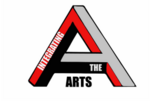
This resource was created by Mason Vrbka, in collaboration with Dawn DeTurk, Hannah Blomstedt, and Julie Albrecht, as part of ESU2's Integrating the Arts project. This project is a four year initiative focused on integrating arts into the core curriculum through teacher education, practice, and coaching.
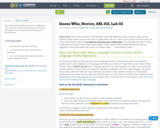
This activity allows students to practice asking each other questions related to who someone is. Students will practice answering questions about physical characteristics.
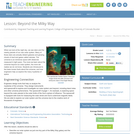
When we look at the night sky, we see stars and the nearby planets of our own solar system. Many of those stars are actually distant galaxies and glowing clouds of dust and gases called nebulae. The universe is an immense space with distances measured in light years. The more we learn about the universe beyond our solar system, the more we realize we do not know. Students are introduced to the basic known facts about the universe, and how engineers help us explore the many mysteries of space.
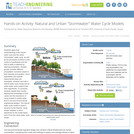
Students apply their understanding of the natural water cycle and the urban "stormwater" water cycle, as well as the processes involved in both cycles to hypothesize how the flow of water is affected by altering precipitation. Student groups consider different precipitation scenarios based on both intensity and duration. Once hypotheses and specific experimental steps are developed, students use both a natural water cycle model and an urban water cycle model to test their hypotheses. To conclude, students explain their results, tapping their knowledge of both cycles and the importance of using models to predict water flow in civil and environmental engineering designs. The natural water cycle model is made in advance by the teacher, using simple supplies; a minor adjustment to the model easily turns it into the urban water cycle model.
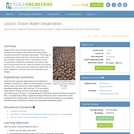
Students learn about the techniques engineers have developed for changing ocean water into drinking water, including thermal and membrane desalination. They begin by reviewing the components of the natural water cycle. They see how filters, evaporation and/or condensation can be components of engineering desalination processes. They learn how processes can be viewed as systems, with unique objects, inputs, components and outputs, and sketch their own system diagrams to describe their own desalination plant designs.

This is a rubric for assessing welds.

This series of visual presentations illustrates common physics principles across vastly different scales, using human-scale photographs, earth science and astrophysics imagery. The products look at such topics as shadows, wind, bow waves and collisionally-excited gas. The intent is to show how familiar processes on Earth are connected to more exotic and less well-known phenomena across the Universe. These laws apply here (in daily life), there (around Earth and the Solar System), and everywhere (throughout the cosmos). The poster set is part of the Here, There, Everywhere (HTE) collection.

In this activity, student teams design small-scale physical models of hot and cold planets, (Venus and Mars), and learn that small scale models allow researchers to determine how much larger systems function. There is both a team challenge and competition built into this activity. Experimental findings are then used to support a discussion of human outposts on Mars. The resource includes an experimental design guide for students as well as a handout outlining a method for the design of controlled experiments, and student data sheets. Student questions and an essay assignment are provided as classroom assessments. This is Activity A in the second module, titled "Modeling hot and cold planets," of the resource, "Earth Climate Course: What Determines a Planet's Climate?" The course aims to help students to develop an understanding of our environment as a system of human and natural processes that result in changes that occur over various space and time scales.

SSAC Physical Volcanology module. Students build a spreadsheet to examine how magma viscosity varies with temperature, fraction of crystals, and water content using the non-Arrhenian VFT model.

The increasing scarcity of drinking water has captured the world’s attention and driven scientists and conservationists to find solutions. This ten-minute video and accompanying lesson has students examine how the country of Namibia has tapped an unlikely source of water to combat shortages and experiment with water filtration materials and strategies.
This lesson is not under an open license; however it is provided free for educational services.
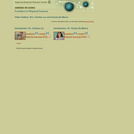
This online video gallery is from the Museum's Seminars on Science, a series of distance-learning courses designed to help educators meet the new national science standards. Part of the Frontiers in Physical Science seminar, the gallery features two videos, available in broadband and modem formats, and with printable PDF transcripts. Dr. Charles Liu gives a quick look at his research on galaxies and the wide range in galaxy size. Dr. Orsola De Marco provides a brief overview of the "life cycle of stars" and the museum's Scales of the Universe Exhibit.
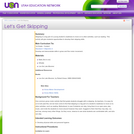
Skipping is a big part of a young studentŐs readiness to move on to other activities, such as reading. This activity will give students opportunities to develop their skipping skills.
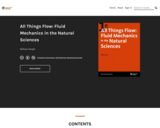
This book began as lecture notes for an Oregon State University course in fluid mechanics, designed for beginning graduate students in physical oceanography. Because of its fundamental nature, this course is often taken by students outside physical oceanography, e.g., atmospheric science, civil engineering, physics and mathematics.
In later courses, the student will discover esoteric fluid phenomena such as internal waves that propagate through the sky, water phase changes that govern clouds, and planetary rotation effects that control large-scale winds and ocean currents. In contrast, this course concerns phenomena that we have all been familiar with since childhood: flows you see in sinks and bathtubs, in rivers, and at the beach. In this context, we develop the mathematical techniques and scientific reasoning skills needed for higher-level courses and professional research. Prerequisites are few: basic linear algebra, differential and integral calculus and Newton’s laws of motion. As we go along we discover the need for the more advanced tools of tensor analysis.
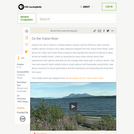
In this video segment adapted from the Yukon River Panel, visit fishing communities along the Yukon River and see how Alaska Native peoples exercise stewardship of salmon to ensure that it remains a central food source and cultural touchstone.
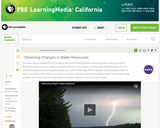
In this video segment adapted from the College of Menominee Nation, tribal members observe lower water levels in lakes and streams and call for global, collaborative solutions to address climate change.

This is the second term of a theoretical treatment of the physics of solids. Topics covered include linear response theory; the physics of disorder; superconductivity; the local moment and itinerant magnetism; the Kondo problem and Fermi liquid theory.

Undergraduate Learning Assistants can be used to supplement the instructor and/or Teaching Assistant during recitations. They may help facilitate productive group work on tutorial activities designed to help students develop conceptual understanding and problem-solving skills. In this example, we describe the use of Learning Assistants to support tutorials within recitation in two introductory science courses physics and chemistry.